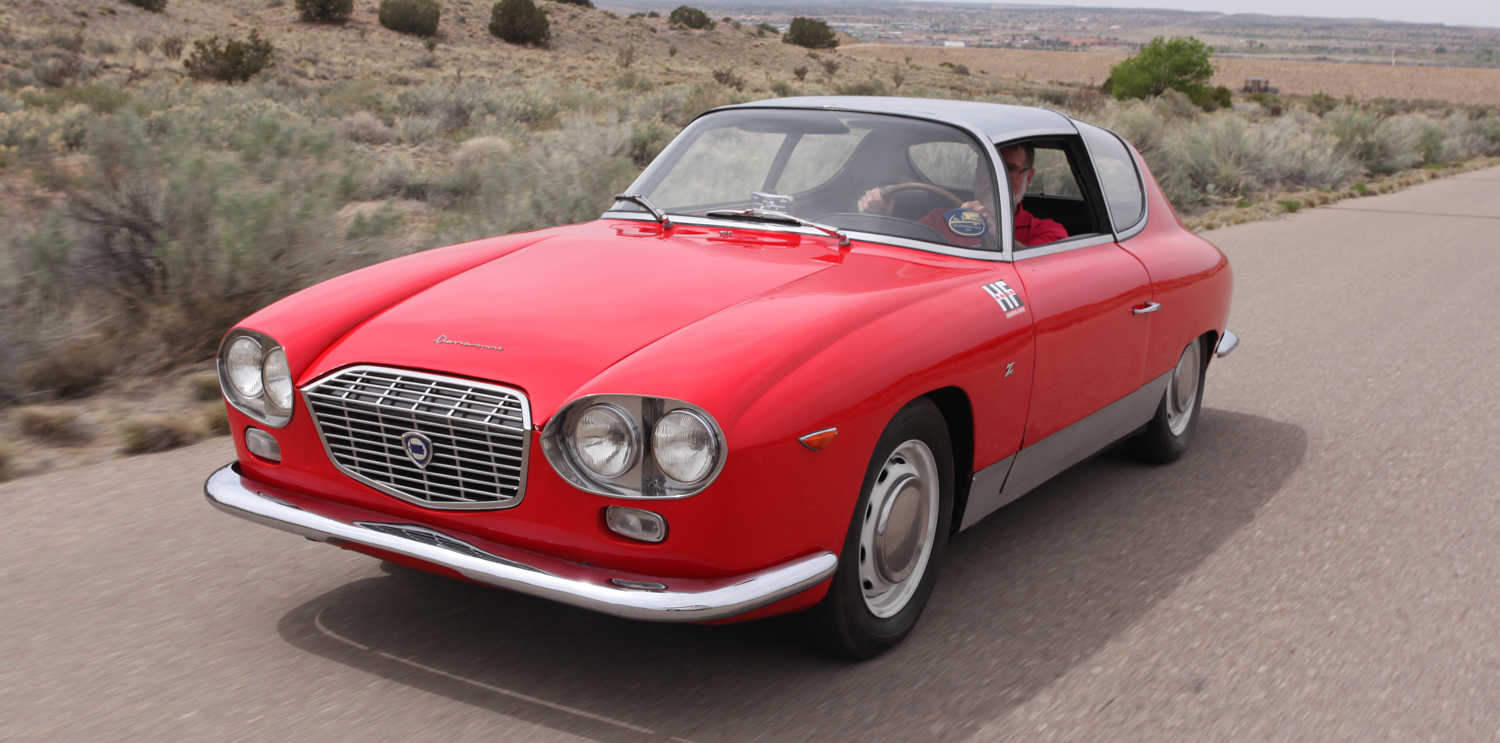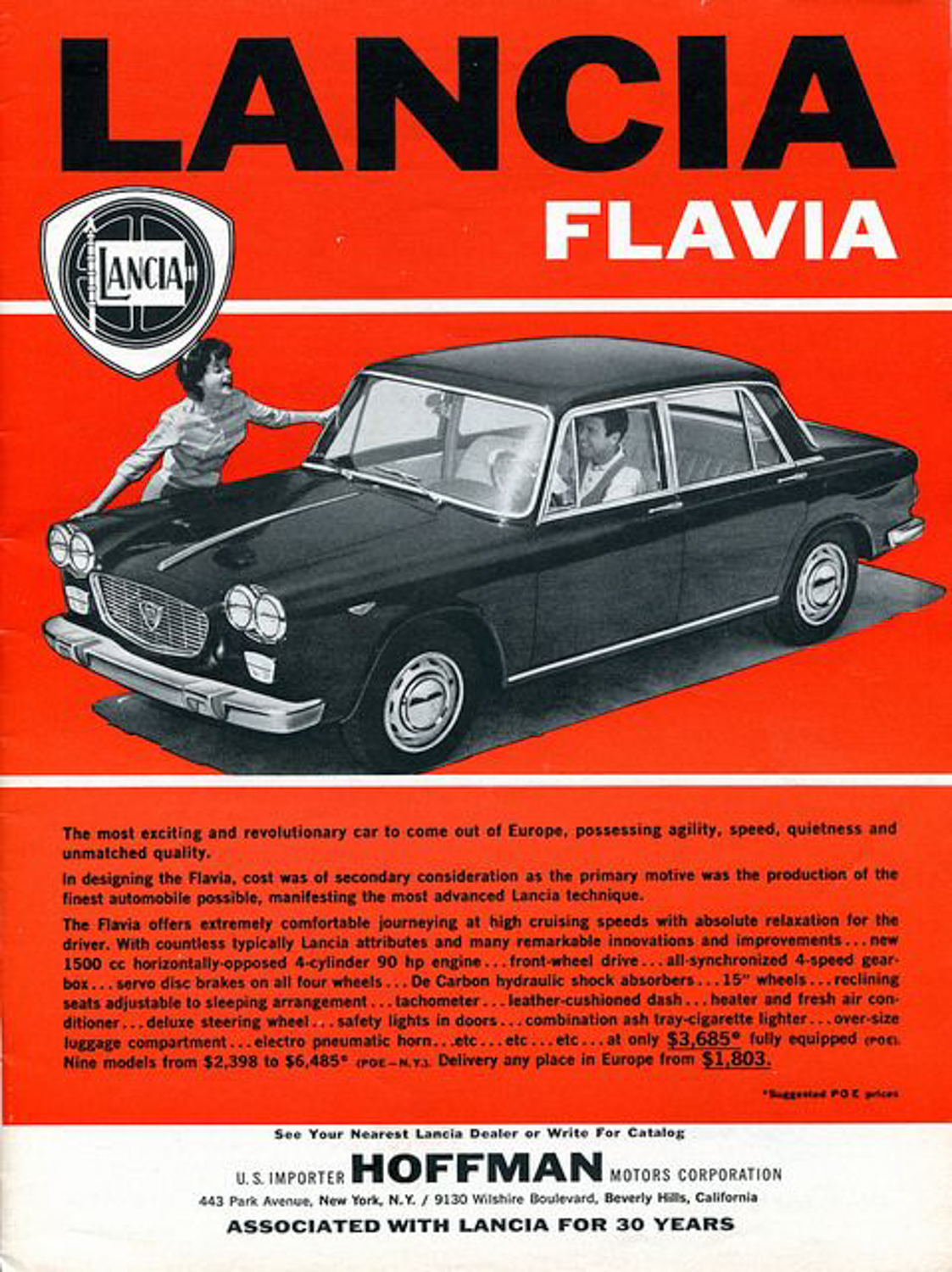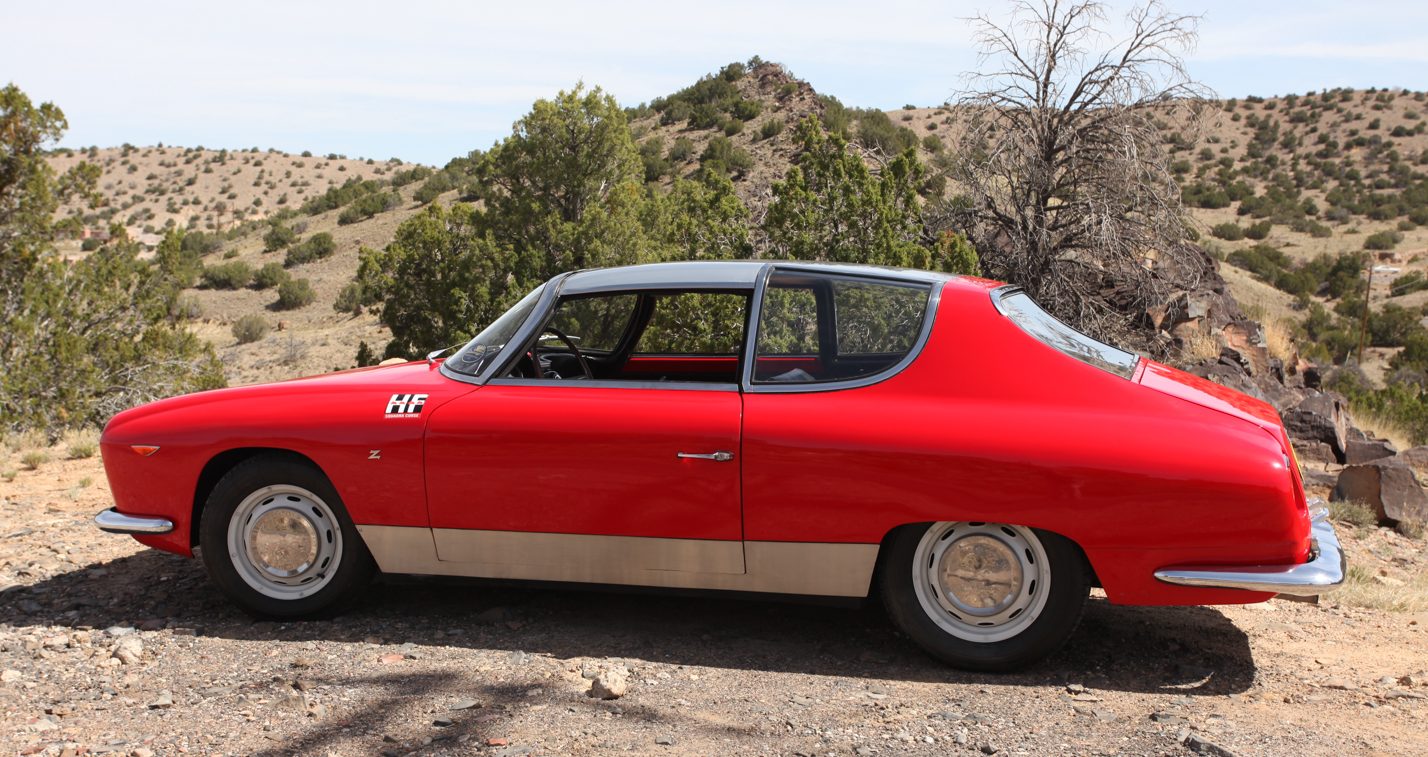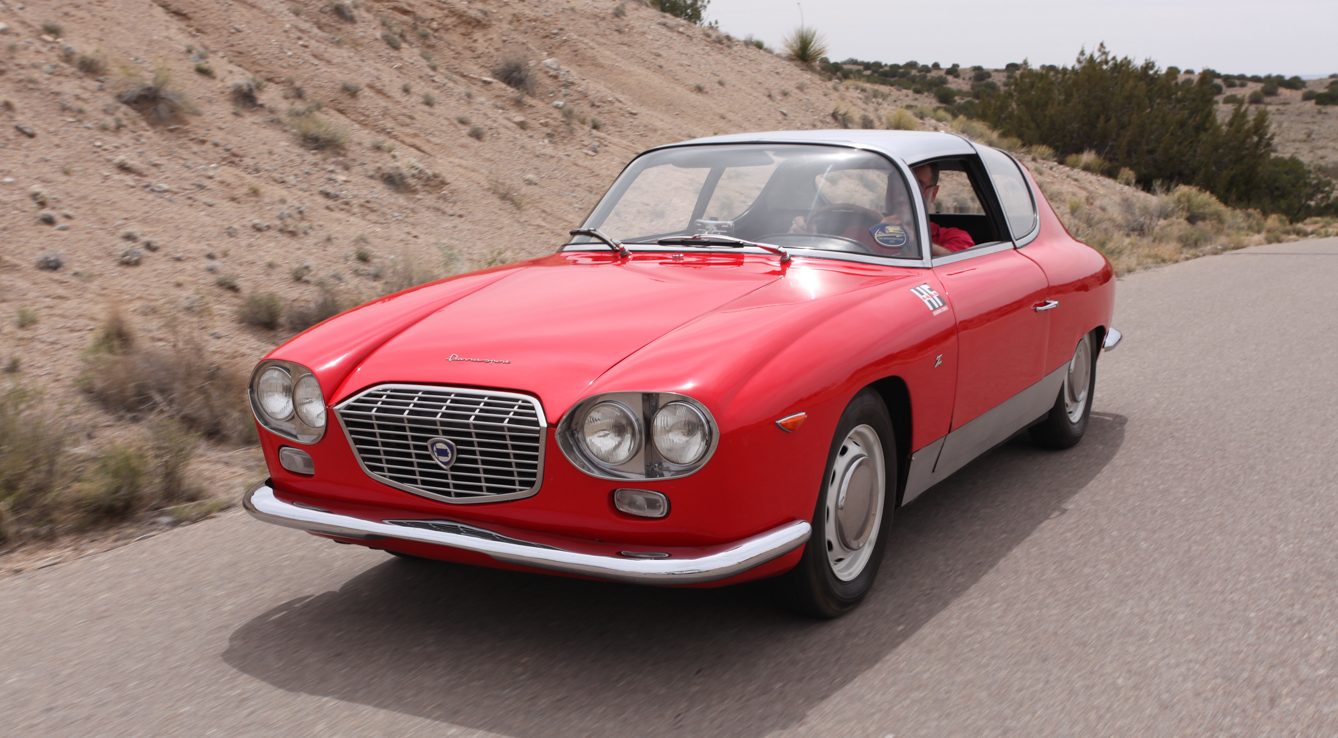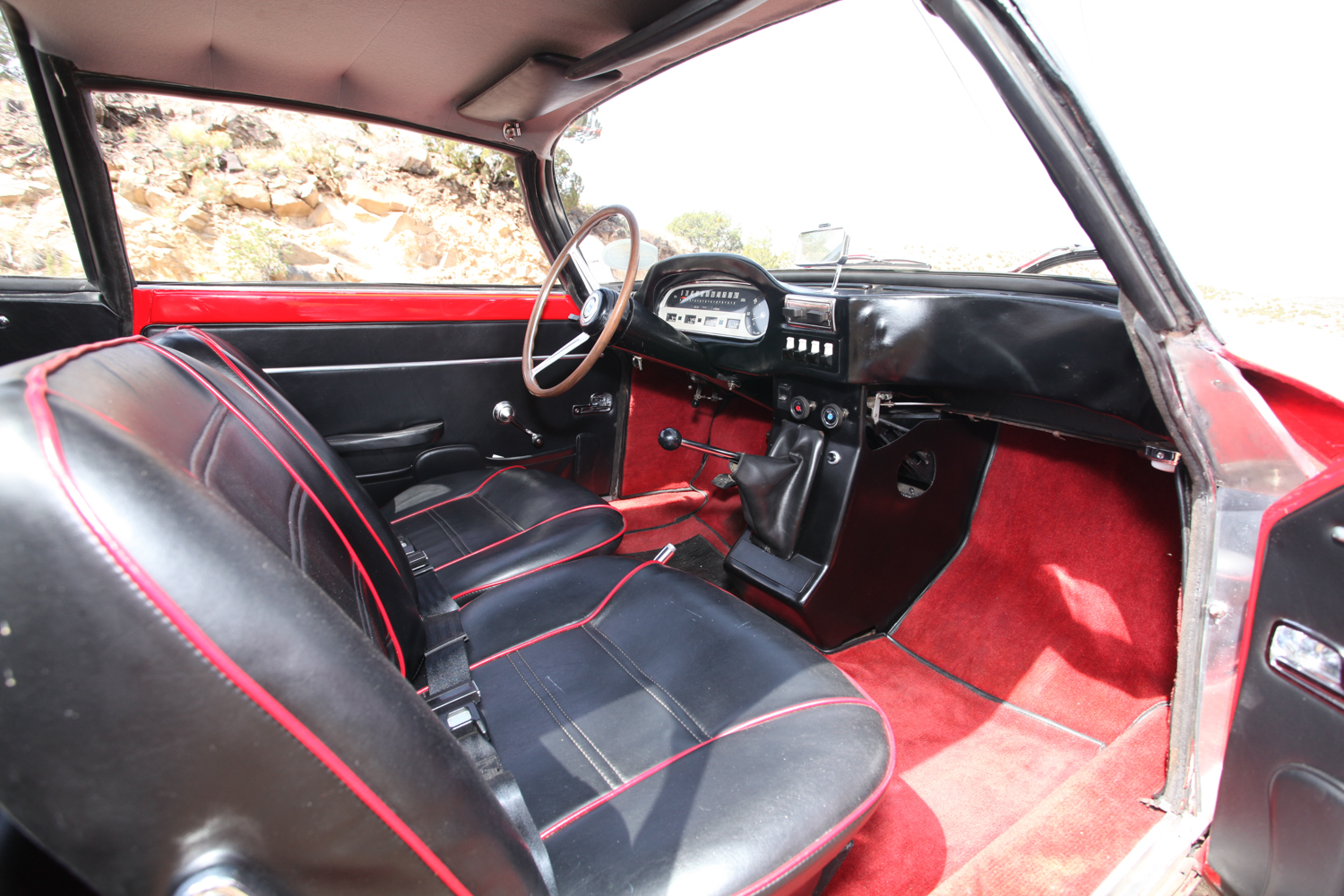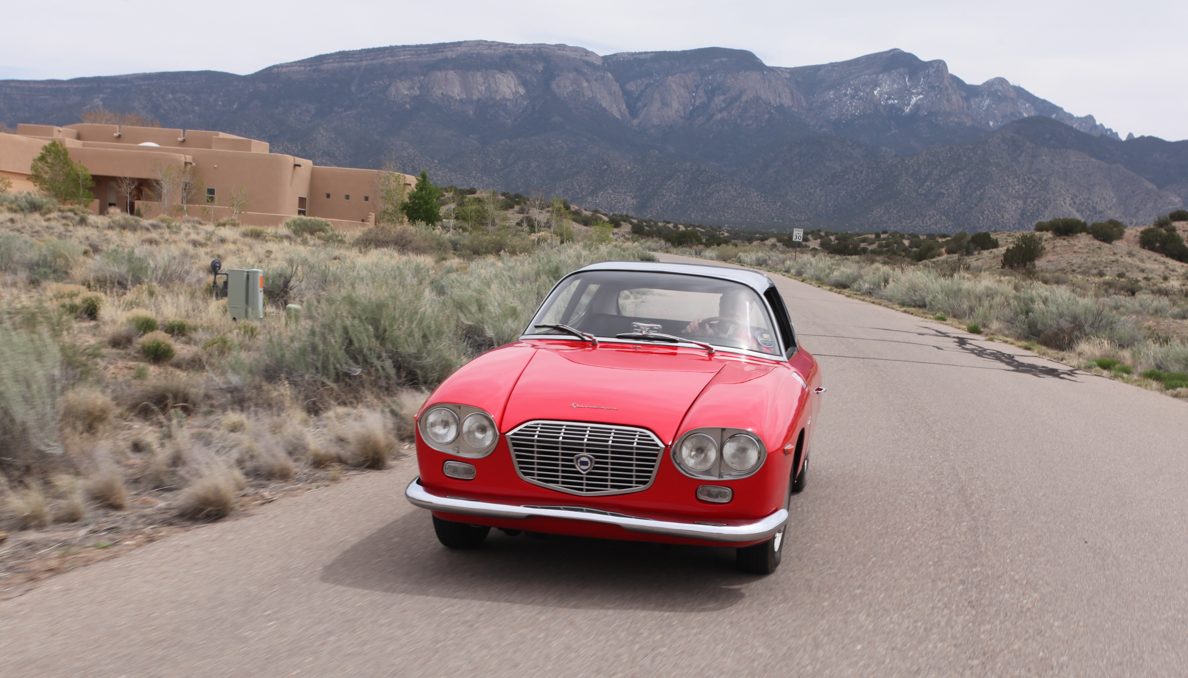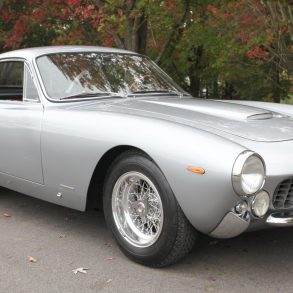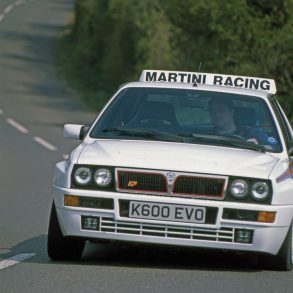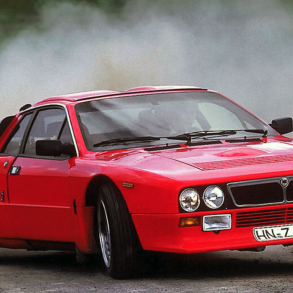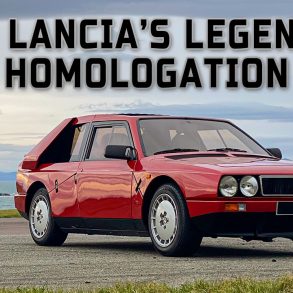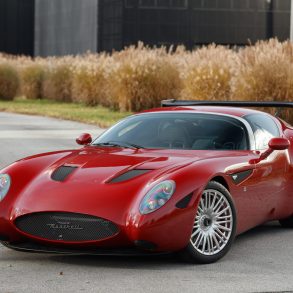Joe Ballengee was driving his ’65 Lancia Flavia Sport Zagato through the Santa Fe Arts District, during the Santa Fe Concorso’s Mountain Tour, when a woman at the curb, shouted, “WHAT ON EARTH?” A more knowledgeable car person, upon seeing a photo of the Lancia, commented that it was “rare as rocking horse poo.” Many cars that were touched by the Italian coachbuilder Zagato produce exclamations and pronouncements such as these, but the Lancia Fulvia Sport Zagato was just that bit more unusual than most other Zagato-bodied automobiles.
In the Beginning
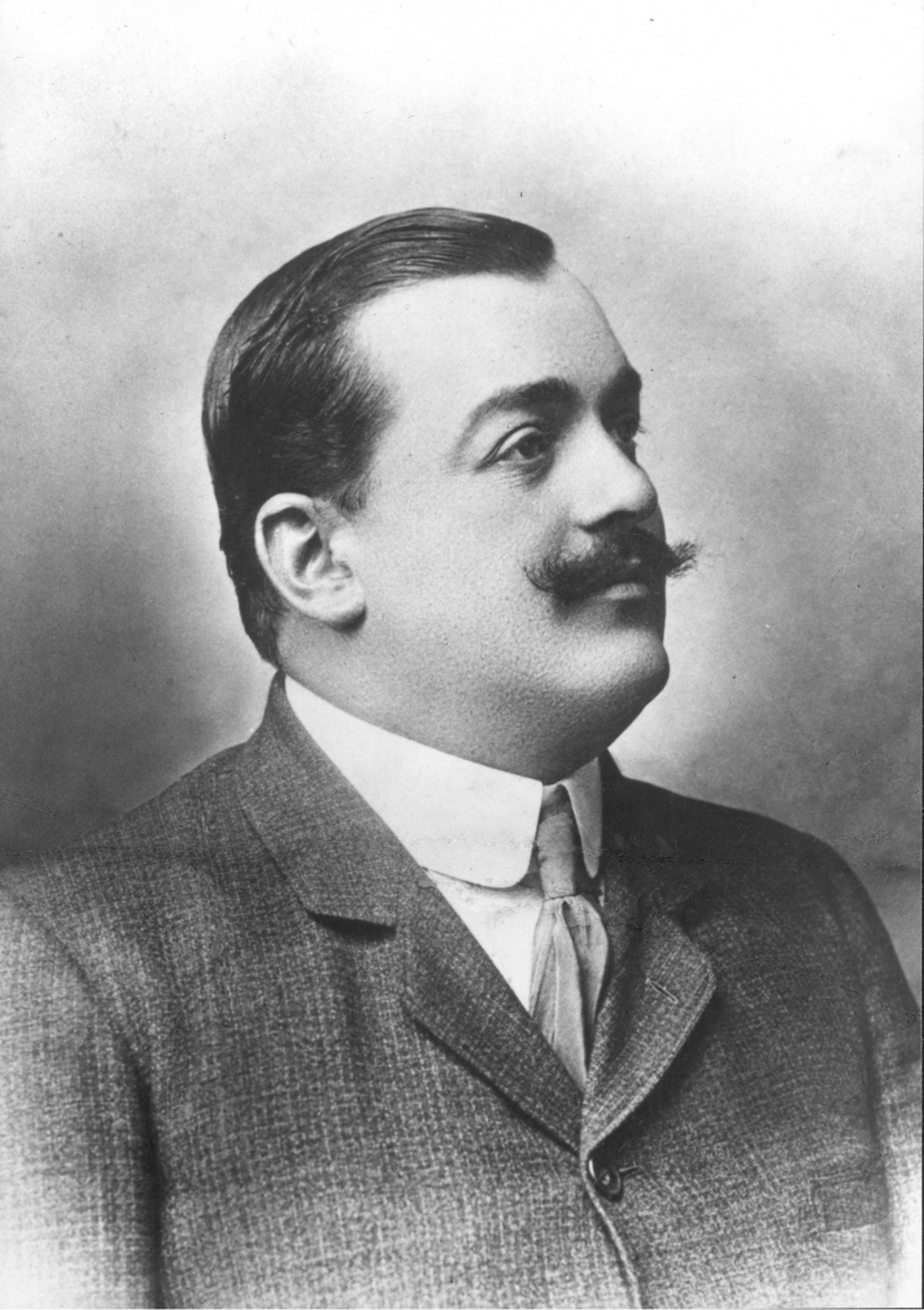
Many parents are sure that they know what is best for their children, but their plans don’t always work out the way they hoped. Giuseppe Lancia had a very successful business canning soups near his family home in Fobello, in the Italian mountains. In his son, Vincenzo, he detected a talent for numbers, so he planned for his son to go to school in Turin to become the accountant for the family business. The Lancia family had a second home in Turin, so Vincenzo had a place to live while in school. Two rooms in the courtyard were rented in order to insure the house remained safe and to provide some income for house expenses. The renter was Giovanni Ceirano, who operated his business, Fabbrica di Velocipedi e Vetture Automobili Giovanni Ceirano, in those rooms.
Ceirano’s business seduced the young Lancia. He was good at numbers, but he was also very interested in things mechanical. And Ceirano had many things mechanical in those rooms. Ceirano was a bicycle importer, and he repaired bicycles. In his two rooms were a lathe, welding equipment, a forge, and lots of tools. Lancia was fascinated, especially when Ceirano began building bicycles and then light cars he called Welleyes.
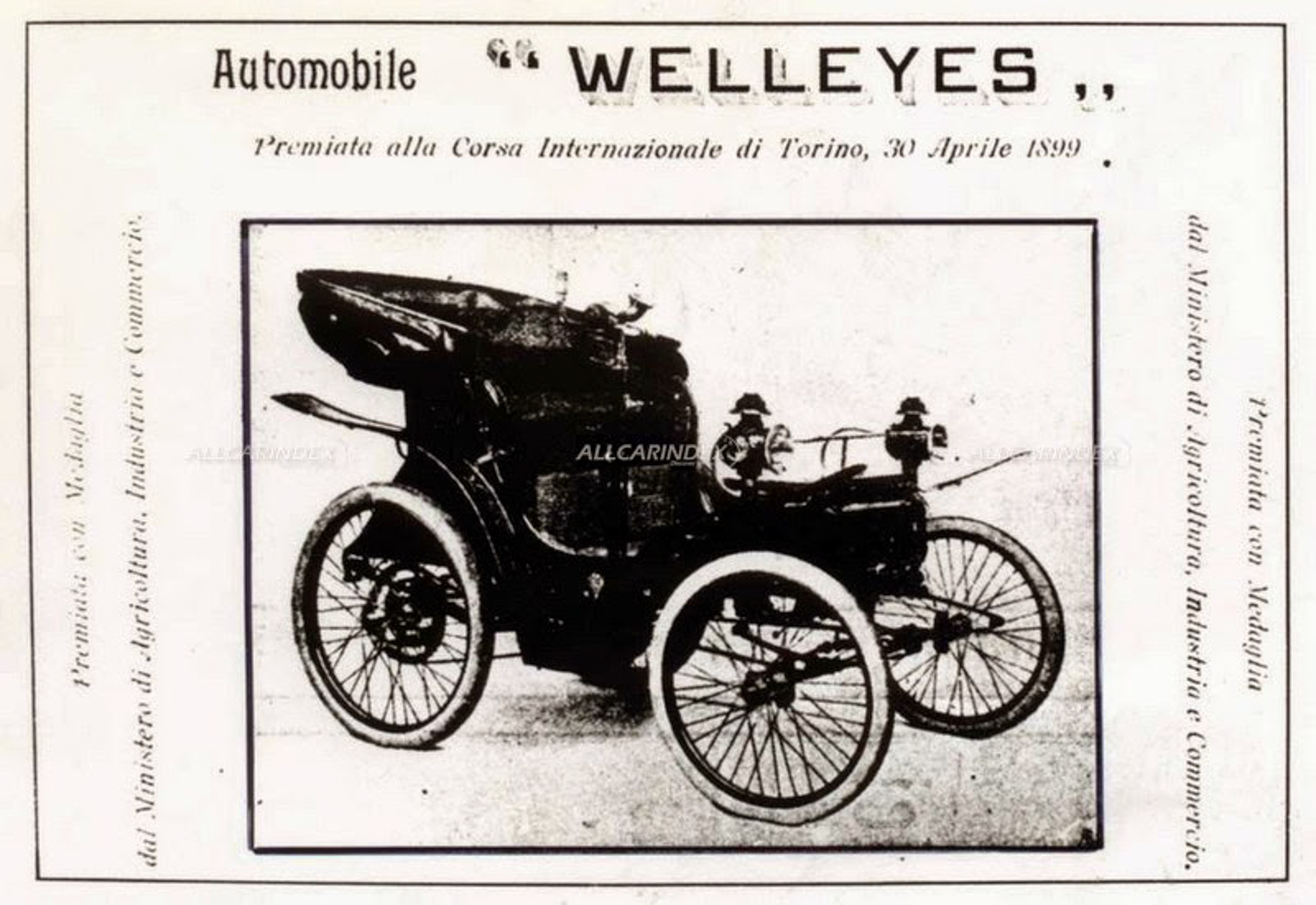
Designed by Ceirano’s engineer, Aristide Faccioli, the Welleyes became quite popular, and the business grew. Lancia dropped out of school and join Ceirano’s Fabbrica as the company’s bookkeeper. Keeping the books, though, was less interesting than being involved with the construction of bicycles and light cars, so Faccioli took Lancia under his wing and trained him about design and the reading of plans. Lancia soon displayed an ability to analyze problems and find innovative ways to repair faults.
The success of Ceirano’s Fabbrica did not go unnoticed. Fiat noticed it, and, looking for new talent and equipment, bought the company and took on its people. Lancia must have built up a pretty good reputation during his two years in Turin, because Fiat made him the chief inspector at their new plant. He was responsible for planning, design, manufacturing, testing, and developing ways to fix design faults that became apparent during testing. Lancia was in his element.
On July 1, 1900, Lancia decided to try racing and entered a 6 HP Fiat in a race in Padua. He won and was hooked. The publicity about that race helped convince Gianni Agnelli to get Fiat officially involved. Lancia was tapped to drive in many of the races the company entered, and he had some very good results, including a second place finish in the 1906 Vanderbilt Cub race.
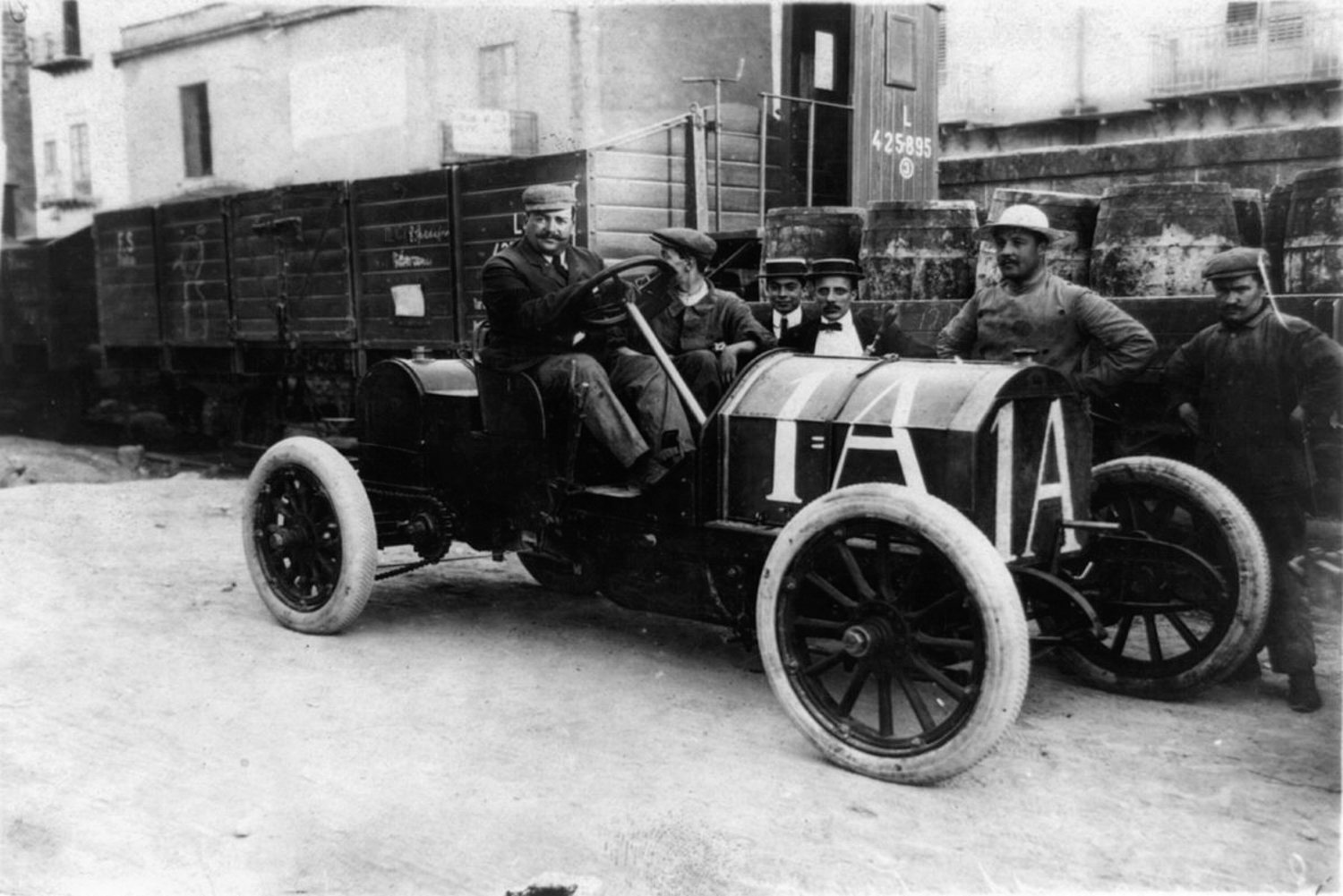
He had nine overall or class victories during the ten years that he raced, but he was also a hard driver and failed to finish a number of races. By 1910, Lancia appears to have lost interest in racing and quit to concentrate on his engineering.
Lancia met Claudio Fogolin when he joined Fiat as a test driver in Lancia’s department in 1902. They became friends and, more importantly, began to discuss establishing their own company. Fabbrica Automobili Lancia and Cia. was formed in 1906 with funds from Lancia, Fogolin, and several friends, including Count Carlo Biscaretti di Ruffia, one of the original founders of Fiat. Lancia would be responsible for the design and development of the new cars, and Fogolin handled sales and the commercial side. They had enough funds to buy a facility no longer in use by Itala, hire 20 employees, and begin the development of a fairly conventional automobile simply called the 12 HP. Two months later, a fire swept through the factory, destroying plans and damaging tools, machinery, and parts. Lancia was not deterred, his next product was a further development of the 12 HP but with a few innovations.
The 18/24 HP Lancia had a four-cylinder engine producing 24 bhp at the amazing engine speed of 1450 rpm. It was light and low and used a shaft drive instead of chain drive. When the prototype was completed, a detail that had been overlooked was discovered – the car was too wide to get through the door of the factory. Lancia had his workers cut away the stone door posts with picks so the car would fit.

Two more prototypes were built, the third having an engine that produced 28 bhp at 1800 rpm. Lancia continued the development of his cars, and, in 1908, took three to the Turin automobile show. There were two models – one with a four-cylinder engine of 2544-cc and a using a four-speed transmission, and a six-cylinder on a longer wheelbase. The four-cylinder was called a Lancia Alfa, using the phonetic spelling of the Greek letter “alpha” and no relation to A.L.F.A., which was formed two years later. The larger car was named a DiAlfa. Like their predecessors, the cars were light, high revving, and very good performers. Reviews were mixed, with some saying the cars were unsafe, but enthusiasts were excited by the cars and 108 Alfas were sold in the next year and a half. Distributors for Lancia opened in the United Kingdom and the United States. Because of their performance, Lancias were often seen successfully competing in races. At the International Light Car Race in Savannah, Georgia, William Hilliard won with an average speed of 52.29 mph for 196 miles. The slogan used by the U.S. distributor became “Built by the Man Who Knows.”

As their successes mounted, the demand for Lancia automobiles also grew and the company expanded into more of the old Itala factory. New models came quickly. In 1909, the first Beta was produced with a 3120-cc, four-cylinder engine. 1910 saw the first Gamma. It was the last car that Vincenzo Lancia would race – his focus was now needed on design and production rather than testing. More sales successes resulted in a need for more room, and in 1911, Lancia moved his works to a larger facility. There the company produced the Delta (4080-cc) and the racing version, the DiDelta, but these cars were still based on the earlier Alfa. Engine capacity continued to be increased, and the Eta (Tipo 20/30) of 1913 had a displacement of 5030-cc. With its shorter, lighter body, it had a top speed of 75 mph! That same year, the first truly new Lancia, the Theta (Tipo 25/35) was a limousine. Lancia had been building a 1Z truck for the Italian military, and it provided the chassis for the limo. The Theta was the first Lancia with a standardized wiring harness.

Even then, Lancia was thinking of how a V-shaped engine could save space in the engine compartment, but his plans had to be delayed. A series of convoluted pacts between countries tumbled down when a Bosnian Serb named Gavrilo Princip assassinated Austrian Archduke Franz Ferdinand and his wife Sophie, and the world found itself in the “War to End All Wars.” During the war, which was much longer for the Europeans than the Americans, Lancia concentrated on making trucks for the Italian military. On the positive side, production during the war resulted in additional expansion of the company’s facilities and capabilities.
After the war, the next car developed was the Kappa with an open touring body and a top speed in excess of 75 mph. It also had a single dry-plate clutch, electric start, floor-mounted gearshift, and a variable rake steering column. Lancia, though, wanted light bodies, and he gave the following advice to his coachbuilders:
“Our experience has proved beyond doubt that it is possible to considerably reduce the weight of bodies hitherto built without affecting their strength and durability. We, therefore, urge body builders to carefully consider every part to be fitted to the chassis so as to produce the finished car as light as possible, which is advantageous for the reputation of the body builder and for us in the satisfaction derived by the owner.”

In the background during the war, Vincenzo continued to expand the concept of the V-engines. By 1919, he had patents on a 45° V8 and a 30° V12. For the Paris show in 1919, he designed a 20° single-overhead cam V12 of 7837-cc and 150 hp at 2200 rpm. It had a new chassis and suspension, but it was not economical to build. A design change to a 20° V8 installed in a Kappa chassis resulted in the TriKappa, [Photo 9] a car with a 4595-cc engine with 98 hp at 2500 rpm. It was to be the last of the traditional Lancias.
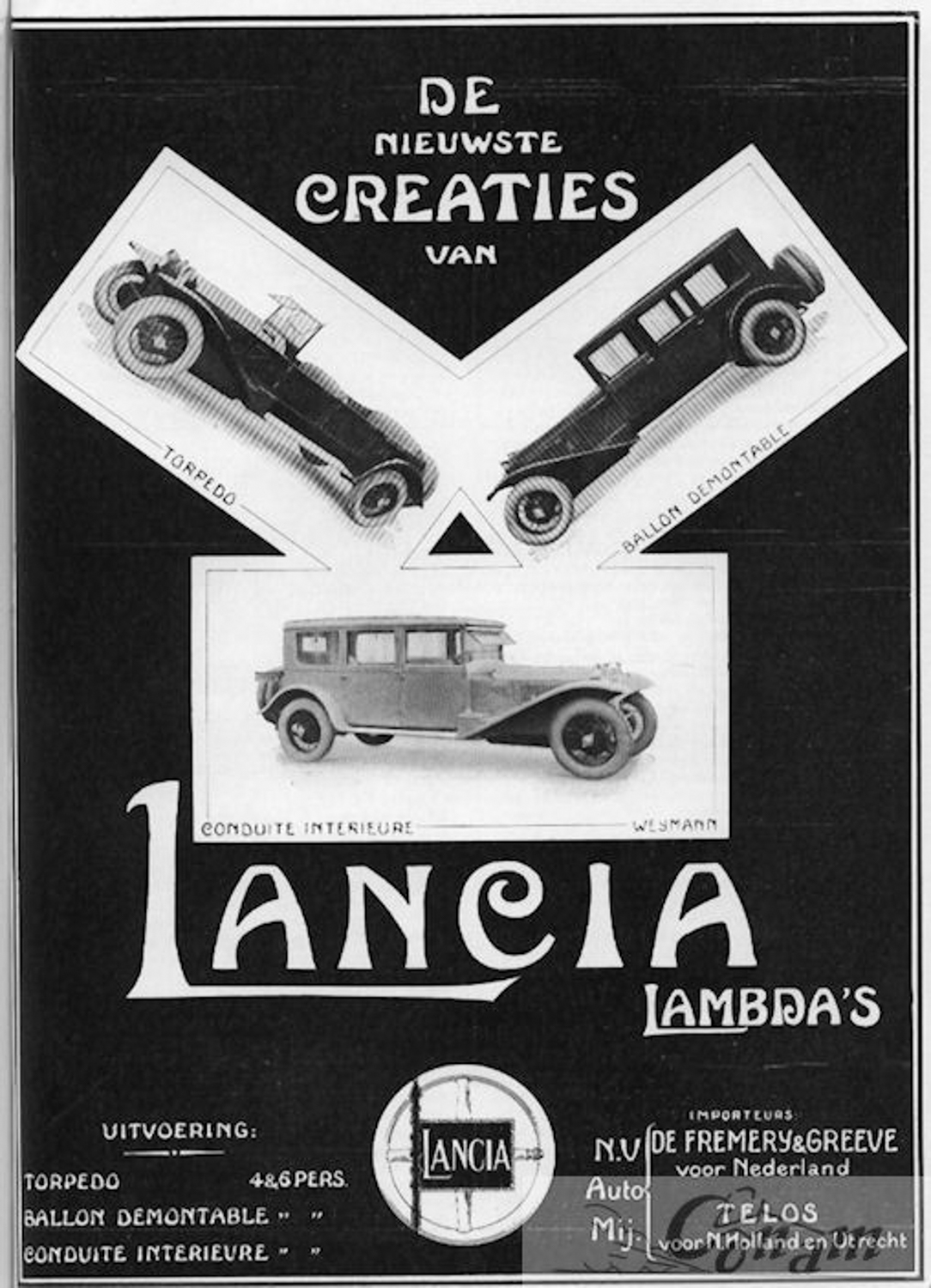
Two things happened to cause Lancia to change his design focus. First, he experienced a near accident when a spring broke on a rough mountain road. Second, he had observed how strong a ship hull was in rough seas. His emphasis changed from lightness and speed to strength and safety. The Lambda would be a very different car than the Lancias that preceded it. By September 1921, the prototype was complete, and a test drive convinced Lancia that the car would be very successful. The Lambda had a very compact, 2121-cc, 13° V4 single-overhead cam engine producing 49 hp. The engine used an aluminum cylinder block and was a very clean design – easy to service. The chassis used an independent front suspension – the first large car to have IFS – with sliding pillars, coil springs, and hydraulic shock absorbers. IFS results in more stress on the chassis, so Lancia strengthened the chassis to manage the additional loads. The Lambda was possibly the first monocoque-bodied car. It was a car well ahead of its time, but it proved to be reliable and practical. It was shown at the Paris and London shows in the fall of 1922. Autocar praised the Lambda, and the buyers lined up to order their car.
The Lambda was hardly a sports car, although a 4-seat version came close to winning the Mille Miglia. It was big, but nimble; light, but not speedy; and it had good roadholding and performance. During its ten-year production run, 13,000 were built. As with other Lancia models, a DiLambda was produced with a V8 and 100 hp at 3800 rpm, but it was a much heavier car.

The decade of the 1930s saw a number of changes. The first and most noticeable was a change from Greek letters to Latin place names for model names. Some new cars were also needed, and the first was the Artena, which used a smaller Lambda engine of 1925-cc and producing 55 hp at 4000 rpm. The emphasis for the Artena was comfort, but it had excellent handling and steering and could reach 75 mph. Next was the Astura, which used the same body/chassis combination as the Artena and a 19° version of the DiLambda V8. Later, the engine would be modified to be a 17 1/2° V8. The car was a popular racer, even beating the Scuderia Ferrari Alfas at the Coppo d’Oro in 1934.
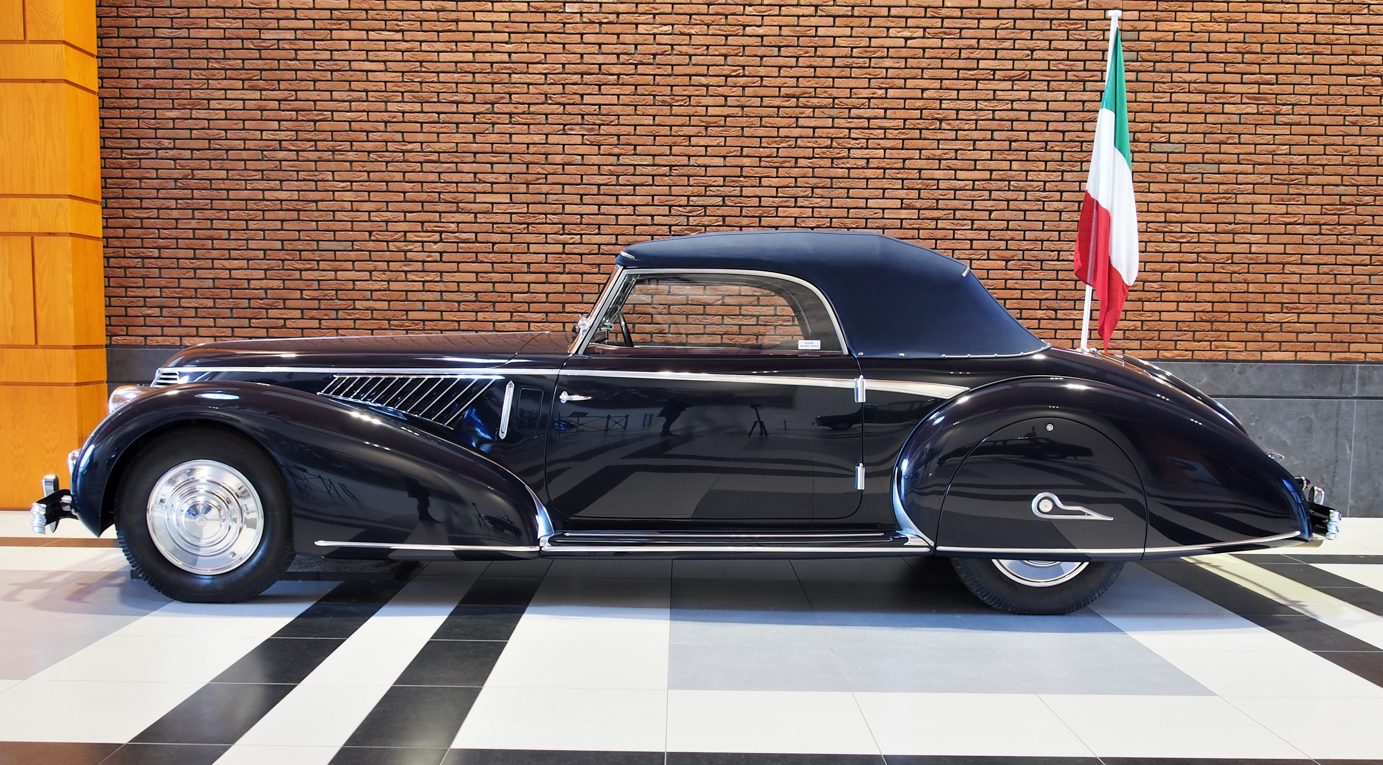
Another change Lancia foresaw, before many of his competitors, was a small, light, efficient car that would survive the Depression. The result was the Augusta. It was a quick, reliable car using a 18 1/4° V4 of 1196-cc, producing 35 hp and a top speed of 65 mph. It was built in only one body style – a four-door, four-seat sedan. To allow ease of access, it had suicide rear doors and no B-pillar. In 1936, Augustas took the first four places in the Targa Florio. It was a very popular car. According to David Owen, in his article, “Lancia Part I – The Vincenzo Years” in Automobile Quarterly Volume 12 #4, Rene Dreyfus related that the Alfa Romeo team drivers used Augustas as their daily drivers instead of the Alfas offered to them at a special price.
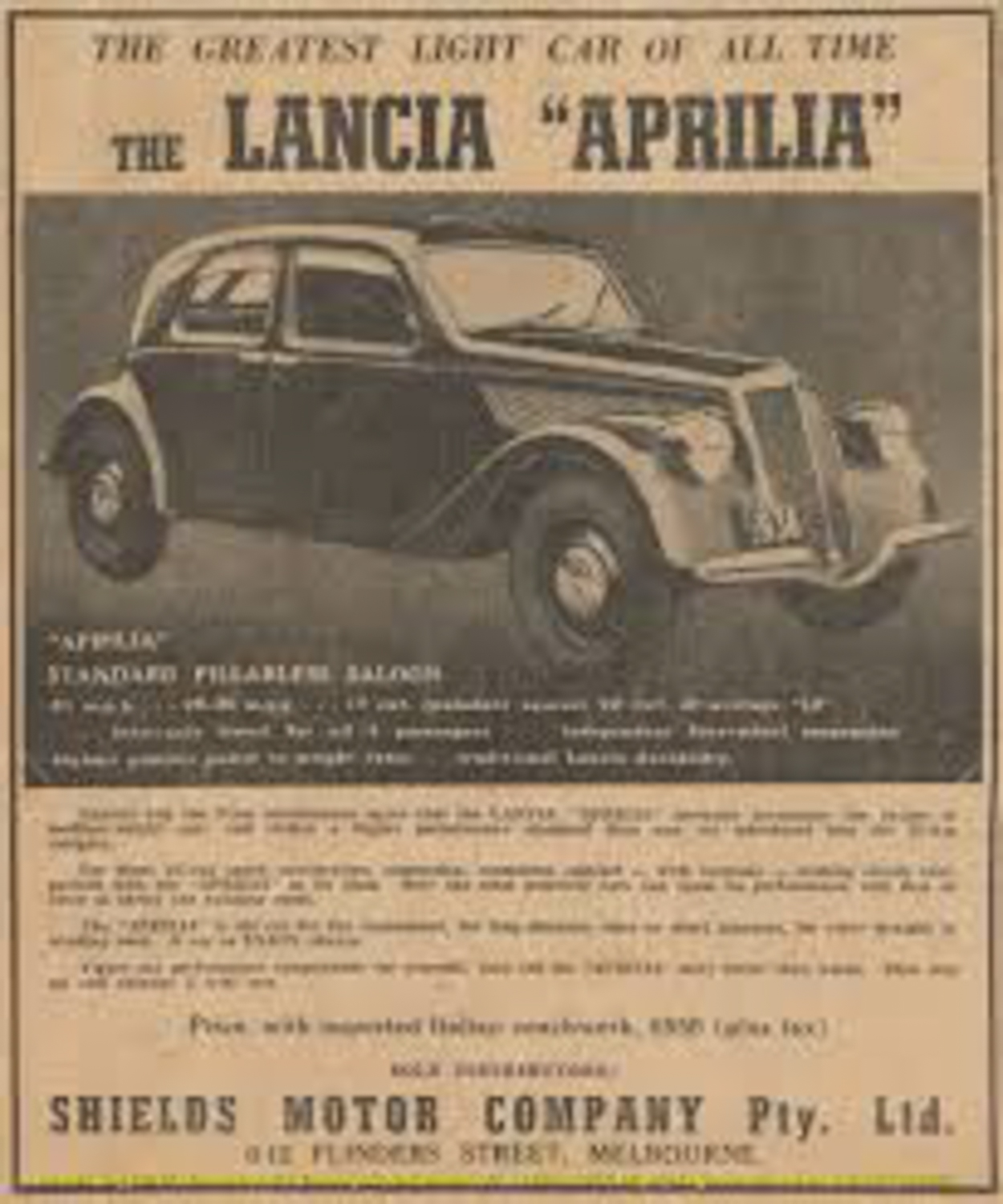
Lancia’s next design was one he started on in 1934. The Aprilia would have a light, thin steel body, stiff chassis, and independent rear suspension with inboard rear brakes. The engine was an 18° V4 of 1352-cc and 47.8 hp at 4300 rpm. Sadly, Vincenzo would never see a production Aprilia. He died of a heart attack in February 1937, at 56 years of age, before the production began.
Gianni Lancia took over the company after his father’s death. He was aided by a technical staff that his father had carefully chosen. The team, and the Aprilia, set the direction for the future of Lancia. Then came the Second World War, the interruption of civilian production, German occupation, and Allied bombing and invasion. During the war, the technical staff evacuated to Padua. They returned, in 1945, to put the pieces of the factory back together and resume production. The pre-war models were still competitive in the market, so that gave them time to develop a new model.
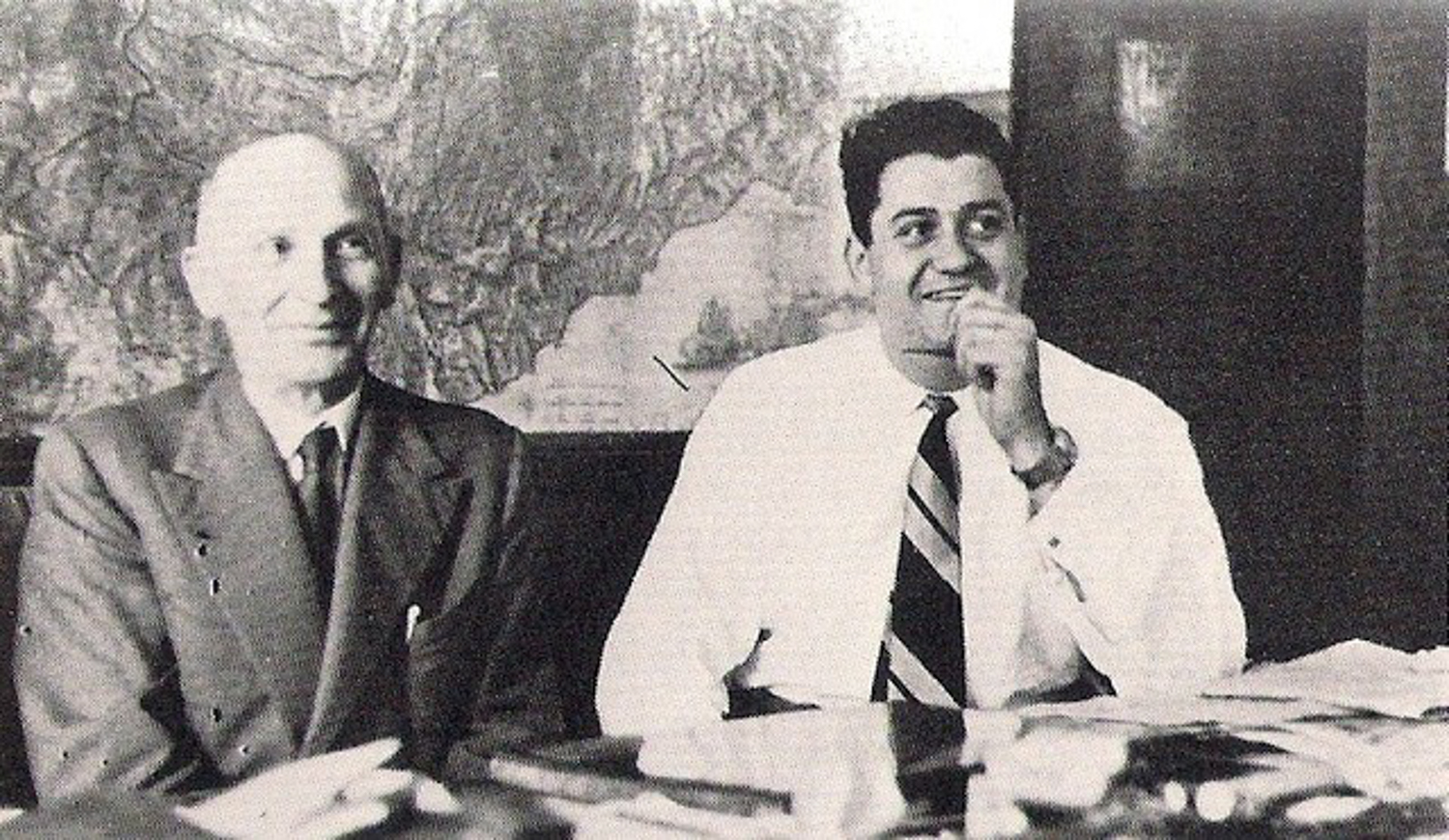
Vittorio Jano had by now been released from Alfa Romeo, deemed too old to be productive, and together with Technical Director Giuseppe Vaccarino, they decided to focus on a V6 project started by Vincenzo. Model development sped up after WWII, so a manufacturer had to up response time to market changes. The Aurelia proved to be a timely model for the new market. With a 1754-cc 60° V6 producing 56 hp at 4000 rpm, the car had good performance and handling. It took the 2-liter trophy at the 1950 Mille Miglia. Gianni saw the possibilities in competition and took the company back with a vengeance.
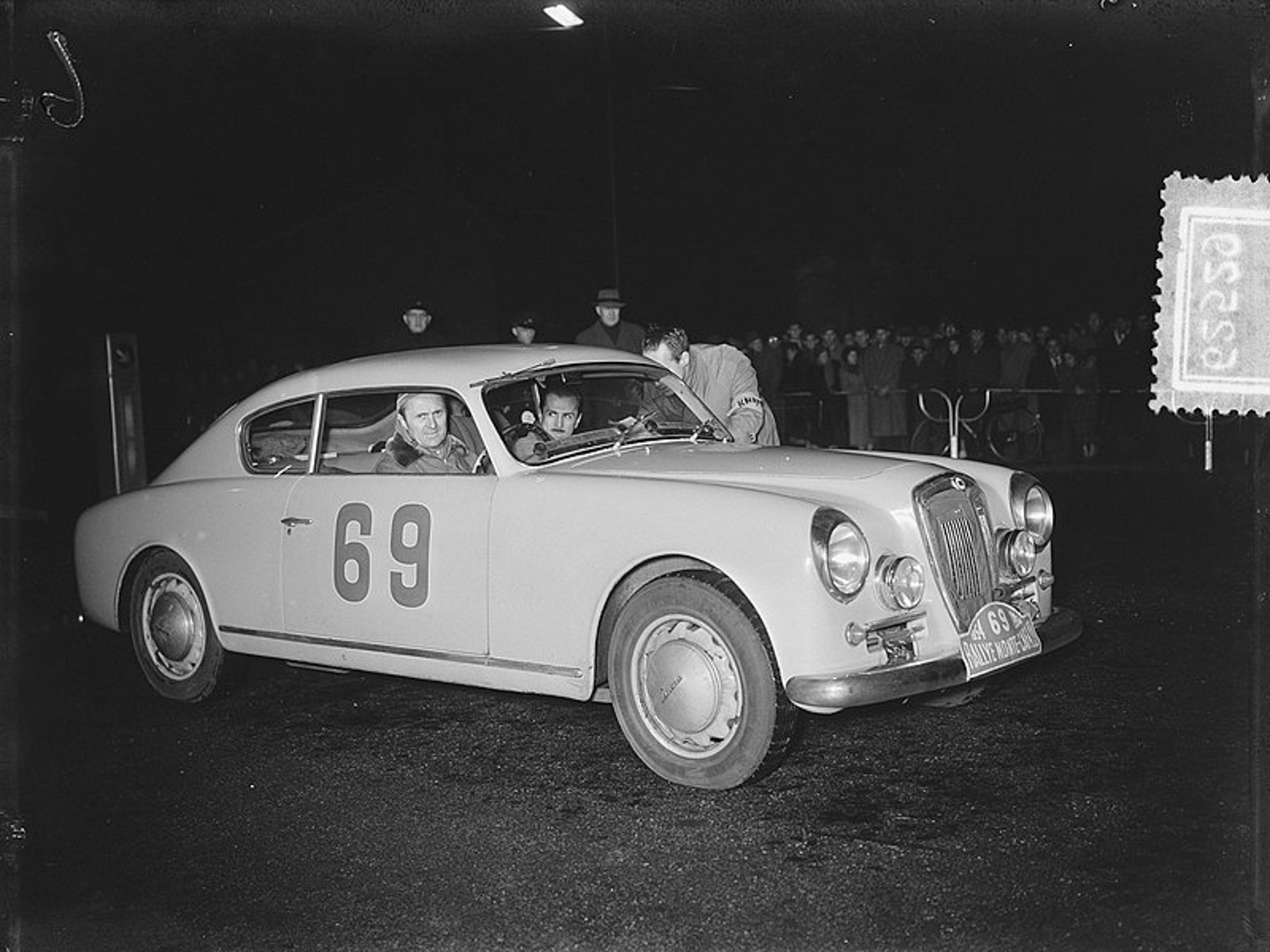
In 1951, four works cars were entered in the Mille Miglia and took second overall from four works Ferrari V12s. An Aurelia won its class at that year’s Le Mans 24 Hours. Development of an Aurelia coupé resulted in more good results both in racing and rallying. The D20 came next with a 217 hp dual overhead cam V6 displacing 2962-cc. The D20 was followed by the D23 and D24 and culminated with the development of the D50 Grand Prix cars. Lancia’s greatest success in competition, though would be in 1956, when the Formula 1 team was turned over to Ferrari, and Juan Manuel Fangio won the championship.

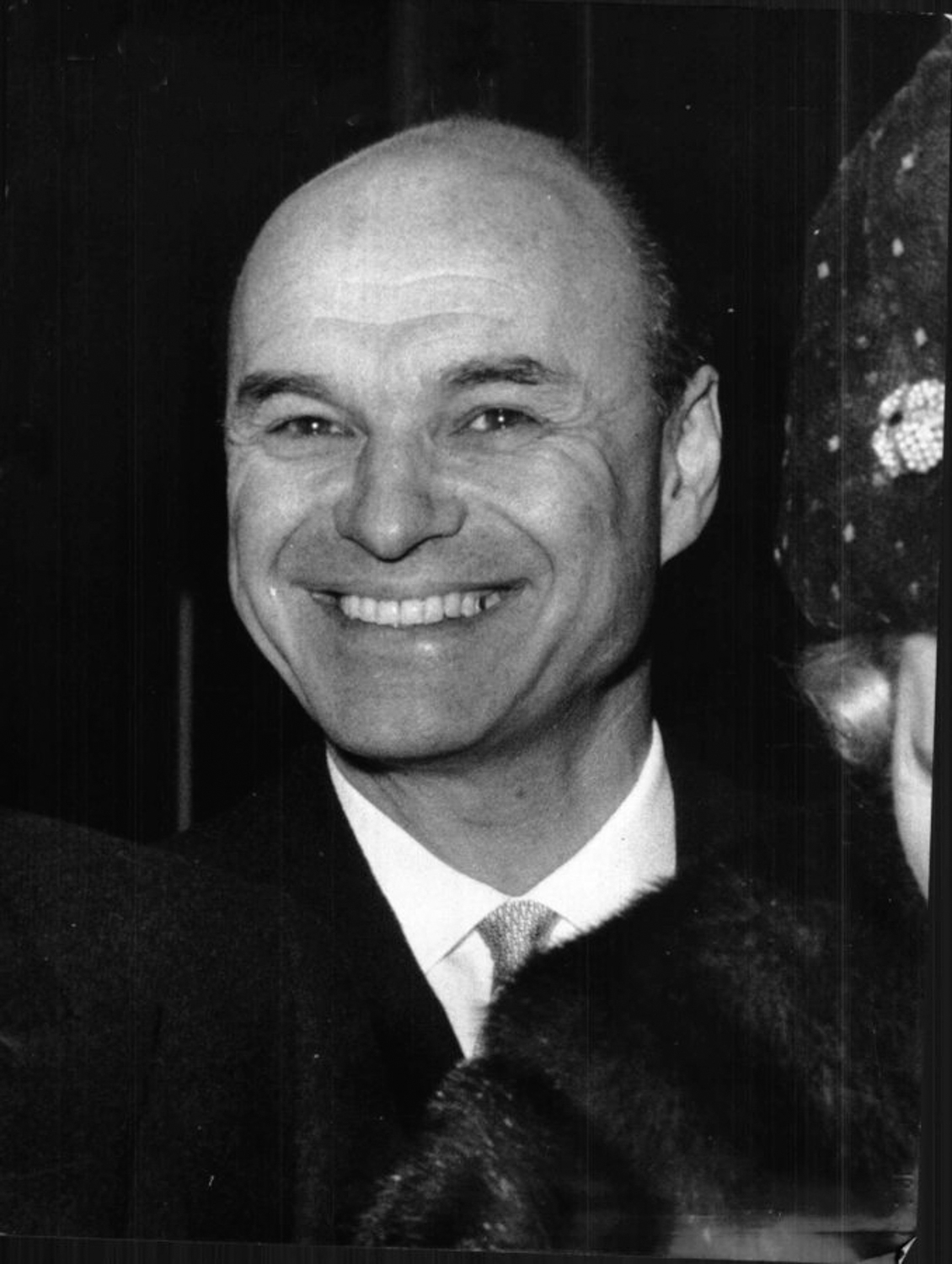
The Formula 1 effort, together with a very expensive development of the new small car, the Appia, put the company in financial distress. The company was rescued by Carlo Pesenti, a cement company millionaire, who took control of Lancia in 1955, resulting in Gianni’s resignation in 1956. The new management maintained the company’s philosophy of building reliable, quality cars. The first new model was the Flaminia, a V6, which continued the approach that had been successful for the previous models. A major change in design approach came with the new Technical Director, Professor Antonio Fessia, designer of the FIAT Topolino. After updating the Appia, Fessia designed a new, very different mid-range Lancia, the Flavia, named after the Via Flavia, a Roman road from Trieste to Dalmatia.
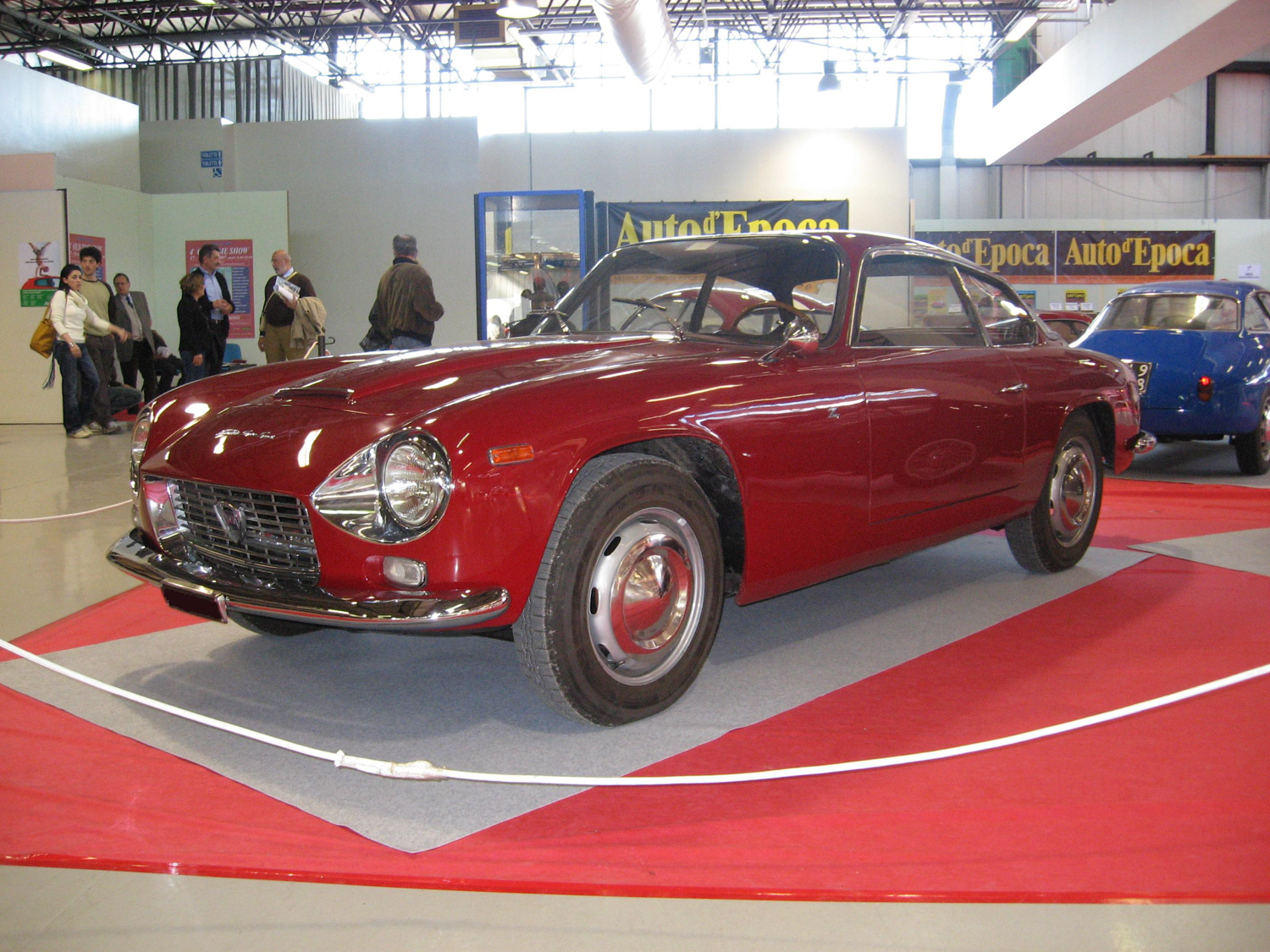
Lancia Flavia
The Flavia was an expansion of a design that Fessia had done before. It was a front-wheel-drive, with an aluminum, flat-four of 1500-cc, a four-speed transmission, and disc brakes on all four wheels. Front suspension used unequal length wishbones. Production started in June 1961, after the prototype was introduced at the Turin Motor Show in 1960. First came a boxy sedan. A Pinin Farina coupé quickly followed, and Zagato made a typically crazy version. Engine size was increased over time to 1800-cc in 1963, then to 1991-cc in 1970, the last year of the model name, although the model continued as the Lancia 2000 after FIAT bought the company. A total of 108,175 Flavias were produced, including 19,293 coupes by Pinin Farina, and a few coupes and convertibles by Carozzeria Zagato and Vignale.
Lancia Flavia Sport Zagato
Someone once commented that their car was a sensuous design, unlike those that Zagato designed with a chainsaw. Well, the cars designed with that chainsaw have become very desirable, in part because of their rarity, but also because Zagato’s designers had the courage to be different. Lancia introduced the Flavia Sport with twin carburetors to provide additional power to what the company hoped would attract people to the coupe. A relatively small number of the coupes were bodied by Zagato, and their look was exotic compared to those built by Pinin Farina. Hardly a panel wasn’t modified. Zagato took an attractive, familiar-looking Italian coupe and turned it into an odd beast, with a two-plane grille that looks as though it could bite, a truly unusual concave rear window, and rear side windows that curve up into the roof in Zagato’s signature panaromica style. With its lightweight aluminum body and low center of gravity, the Sport Zagato was a popular car for rallying and racing. There is little doubt that few other coupes of the period looked anything like the Sport Zagato. The first Sport Zagatos were produced in 1962, the year after the Flavia was introduced. Production of Lancias by outside coachbuilders ended in 1969 when a new model was introduced. Even though the Sport used the relatively inexpensive Flavia chassis, the original cost of the Sport Zagato was more than a Jaguar E-Type, influencing sales of the cars. Of the 626 outlandishly-styled Zagato coupes eventually built, 98 had the 1500-cc engine, and the rest used the 1800.
https://www.youtube.com/watch?v=LwzUu78-TC8
SN 815532001413
A young Joseph Kenneth Ballengee lived in southern Italy while his father was stationed there from 1967 to 1969. He saw all kinds of Italian cars and became familiar with Lancias. Ballengee was and still is a collector of 1/43-scale die cast model cars. When he saw a model of a Lancia Flavia Sport Zagato, he bought it for his collection because it was “an interesting, weird, ugly car.”
After he joined the Air Force in 1975, his interest was rekindled in Lancias when he bought a Lancia Beta HPE. He was familiar with the marque, and the Beta was a fun car to drive. In 2009, he retired to Albuquerque, where, “Every once in a while, I’d go on eBay and type in Lancia just to see what came up. And then this Zagato Sport showed up.” He knew it was rare, but he didn’t know how rare. Doing his research, he found an article about this car when it was in England. He fell for it! The owner had a number of cars and was “thinning the herd.” Ballengee did a “Buy it Now” without even having anyone look at it – he really wanted this car. It was number 413 of the 626 Sport Zagatos built. He had bought a Sport Zagato, so he rented a car dolly and drove to California. When he got it home, his new house was still being built, so the Lancia went into storage. The car needed brake work, so Ballengee did the brakes in the storage unit. The house was completed in 2010, and the Lancia has been there ever since.
Ballengee has done a lot of the work the car needed himself, sometimes because what needed to be repaired was so unusual, there was no one else to do it. Repairs such as flushing and cleaning the radiator; repairing the gas tank, fuel pump, and lines; rewiring the rear lights; and rebuilding the carburetors were pretty standard. Restoring the gauges was a challenge. The ribbon speedometer “runs by strings and pulleys – like reel-to-reel tape recorder.” He had to do that himself. Head gaskets were a problem for the Flavias, since Lancia used copper gaskets on the aluminum engine resulting in corrosion. There were some things he dare not do. While he was able to do most of the work on the car’s brakes, he recognized that stopping would be particularly important while living on the side of a mountain. To insure that the calipers were in the best condition possible, he sent them to White Post Restorations in White Post, Virginia, a firm well known for rebuilding all kinds of calipers.
When you own a rare automobile, according to Ballengee, you get invited to upscale car shows, although the car might be put in an odd class with other weird vehicles. “The Lancia was the only non-truck in one show!” One of the upscale shows was the Santa Fe Concorso a year when Janet Guthrie and Stirling Moss were honored. “We did the entire weekend – it was the most fantastic weekend of my life.” On Saturday, he did the mountain tour from Santa Fe to Los Cerrillos – 80 miles. “It was the longest trip with the car to date.” “While passing through the Santa Fe arts district, as I turned a corner, a woman shouted ‘What on Earth?’ Yes! That’s exactly what I’m going for! Then, Guthrie, driving the photo car, a white BMW convertible, speeds past, and pulls in ahead of the Lancia. We got lots of photos of the car.” He smiled remembering, and said, “The car ran great, stopped great, 70+ mph.” His class in the concours was Import Closed 1964-1967, and it included an Aston Martin DB4, a perfect E-Type, an Austin Healey 3000 rally car, a Ferrari, and a Porsche 911. Ballengee and the Lancia received the Director’s Award, an award given by the Directors of the concours for cars that are particularly interesting. He commented that, “real car people find this car interesting.”

Driving Impressions
When I asked Ballengee what it was like to drive the Sport Zagato, his immediate reply was, “It’s a real hoot.” And so it is! With the aluminum body, and a flat-four engine sitting low in the chassis, the center of gravity is somewhere around your ankles when you’re driving the car. It just handles amazingly well. But that’s getting ahead of the story. First you have to get into the car and be comfortable with your surroundings.
This is not a car for exceptionally tall people. Entering the cockpit requires some contortions – not terrible, but there is some bending required. Once inside, headroom is tight, but the seats are quite comfortable. If you are familiar with Italian cars of the era, the interior will look very familiar – black leather seats with red piping – and red carpets. Nice. And there’s a back seat for a couple kids, although vigorous driving might cause them to slide around a bit back there.
The steering wheel is nicely placed for arms out driving, and the hanging pedals are reasonably placed, although the gas pedal is hinged at the bottom. The gauge cluster does take a little getting used to. The ribbon speedometer is unusual for a performance car, and this certainly is a performance car. It’s something more often seen in sedans – right, the first Flavias were sedans. There is a normal array of gauges below the speedometer, although they are in rectangular bezels instead of the more usual round bezels. From the left side, there is Benzina (fuel), Aqua (water temperature), Olio (oil pressure), and Ampere (battery charge). On the right of the speedometer is a large round tachometer. The one control that was a bit difficult to adjust to was the shifter. When you look at its position, it looks normal, but the gates for first and second gear are far to the left and quite low, a positioning that caused me some grief once I got going. It has a four-speed box with reverse to the right and down. To start the car, give it a couple pumps on the gas pedal, turn the key, push it in to engage the starter, then give it a bit of gas. Once I found first, I discovered that the clutch engages quite high; those are the things you try to remember when you’re driving someone else’s rare automobile for the first time.

The Lancia Flavia Sport Zagato, despite its few eccentricities, is a fun car to drive. The all synchro gearbox is a pleasure once you figure out where the gates are. The car handles curves as you would expect from a streetable racecar, and its power surprises you, thanks to its dual carbs and light weight. Steering is good, the sound of the engine makes you smile, and the brakes work very well. Even though the car has no side mirrors, visibility is good because of all the glass area. After I profile a car, I sometimes ask myself if this is one I’d like to own. The answer for the Sport Zagato is… Oh yes!
Specifications
| Chassis | Steel, shortened wheelbase Flavia chassis |
| Body | Aluminum fastback by Carrozzeria Zagato |
| Engine | Aluminum horizontally opposed 4-cylinder, overhead valve, 2 valves per cylinder |
| Displacement | 1800 cc |
| Bore/Stroke | 88mm (3.46 inches) × 74 mm (2.91 inches) |
| Horsepower | 101 bhp (75 KW) @5200 rpm |
| Torque | 113 ft-lbs (153 Nm) @ 3500 rpm |
| Compression Ratio | 9:1 |
| Ignition | Spark-ignition, 4-stroke |
| Induction | 2- Solex C35 PII carburetors |
| Redline | 6000 rpm |
| Drive | Front wheel drive |
| Length | 4400 mm (173.2 inches) |
| Width | 1570 mm (61.8 inches) |
| Height | 1290 mm (50.8 inches) |
| Wheelbase | 2840 mm (97.6 inches) |
| Front/Rear Track | 1300 mm (51.2 inches)/1280 mm(50.4 inches) |
| Weight | 1060 kg (2337 lbs) |
| Brakes | Dunlop disc brakes, all four wheels |
| Suspension | Unequal length wishbones |


